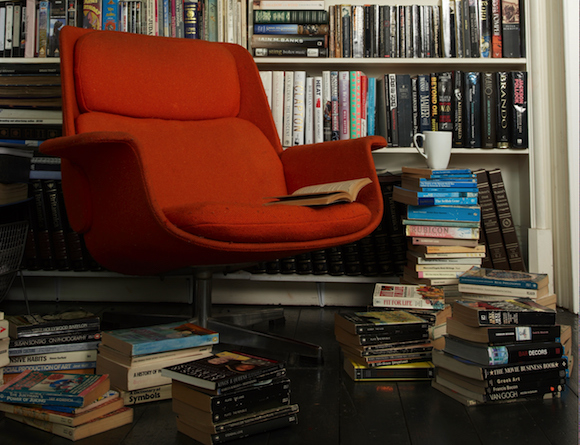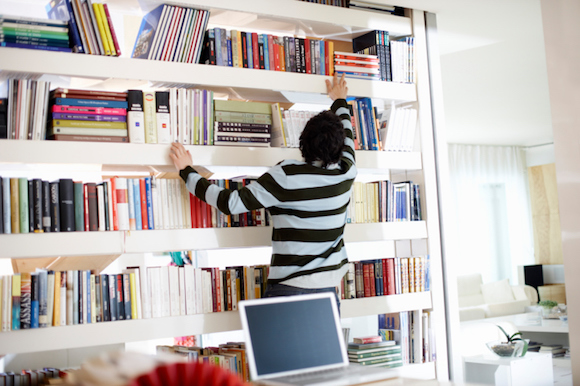Book collections are one of the most overlooked home areas in need of organization. Even if you’re not actively scanning your shelves in search of a new book to read every week, having an organized space to house your favorite stories is the best way to ensure you’ll actually enjoy them. But it can be tricky to know where to begin.
That is perhaps because book worms have very different ideas on the best methods of book organization, and can be extremely passionate about their preferred method. That said, you should consider the various ways of organizing books and choose the one that works best for you. At the end of the day there is no right or wrong way to organize your books as long as you choose a system and follow it.
Here are a few simple tips for decluttering, organizing, and arranging your books in style.
Choose an Organizational Method
There are many ways to organize your books, but only one or two will make sense for you and your home. As with the decluttering process, first decide how and what you’ll be using your book collection for.
If you have a lot of books from a wide array of different authors and genres, you may want to organize them in a more methodical, precise way—in alphabetical order by book title author, subject, or genre.
If your collection of books is smaller and less diverse in type—all young adult fantasy epics or all biographies, for example—you may be better of organizing them in a visual way.
Here are the most common methods for organizing your home library:
- Author’s last name
- Book title
- Subject matter
- Size
- Color-coding
If you arrange your books by subject, you can further arrange them by author or title. Alphabetizing makes it easier to find a particular book when you need it. When it comes to a collection of non-fiction books, a popular method is to order them chronologically, so that the the most current books are located together.
When it comes to placing your books on a shelf, you might find it easier to separate hardcover books and paperbacks.
Shelve With Purpose
Ellen Delap, a professional home and office organizer from Texas, recommends lining up your books vertically next to each other by height, for a “truly organized look.”
This way you won’t have varying heights or depth, which can look messy to the eye. Keeping all your hardback books together and all your paperback books together is another simple way to create a clean, streamlined look.
Bonnie Dewkett of the Joyful Organizer suggests making sure you can easily see spines and reach books when you want to read them.
“If you can’t easily grab and read, [the books] will just collect dust on your shelf,” Dewkett said.
Don’t forget to leave some room for new books, says Jennifer Lava, an Austin-based professional organizer.
“As new ones come in, consider what other ones you don’t like or need anymore and let them go,” Lava said.
Add In Some Style
Styling your bookshelves or bookcase is an easy, low-maintenance way to add movement to a room and show a glimpse of your personality. To add depth to your bookcase or make your shelves look more dynamic, Lava recommends leaving some books standing vertically and others stacked horizontally. Having different height levels on different shelves—while still lining up the spine heights—keeps things interesting without looking chaotic.
Instead of standard bookends, use beautiful decorative items or souvenirs. These can be anything from a pretty ceramic vase or framed artwork to an elegant candle, tabletop clock, or glass jar.
“Intersperse other interesting objects or photos through your collection to give viewers’ eyes an interesting path to travel around your bookshelves,” Lava said.
If you don’t have the space to display personal items or treasures, but still want to add a bit of visual intrigue or personality to your collection, consider color-coding your books. Grouping them this way makes a bold style statement, and it’s a simple way to bring color to an otherwise neutral space in your home.
To Stack or Not to Stack
You will find some devise opinions on whether to stack books vertically. It can be a way to visually mix up your book collection, but some die hard readers won’t tolerate anything besides traditional horizontal stacks.
Stacking books vertically on a shelf can make it difficult to pull one out that is at the bottom or in the middle, especially for children. But used sparingly it can be a good way to present a small collection of books for visual display. There are also some book shelves specifically designed to hold stacks of books, making it easy to snag a particular book without having them tumble down like a Jenga tower.
Pare Down
While you are organizing your books, now is a good time to let go of the books you no longer need or want. Deciding which books to keep and which to part with is rarely an easy decision though, especially if you’re an avid book reader and have been growing your collection for years.
“If you didn’t like it, or will never read it again, or it is just a yuck feeling in your gut, let it go,” says Lava.
Another method is to first identify what you’ll be using your books for and how you want your book collection to look and feel. For example, maybe you want your collection to be a mini library of literary classics, perhaps you need an organized space to display all your reference books or cookbooks, or maybe you just want a cozy home for the stories you pick up to reread year after year.
“Decide what your purpose and vision for your books is, then decide what to keep and what to let go,” says Delap.
Another perk of purging? You will have more shelf space for more books that you actually want to read.
Donate Old Books
Now that you’ve determined which books are special or important enough to hold on to, it’s time to get rid of the ones you no longer need. You can donate your used books to your local library, church, foster home, or shelter. Dewkett of also suggests offering them to nearby senior centers, schools and Goodwill centers.
If you are so inclined you could even build a tiny library outside on the edge of your property.
Delap recommends downloading an app that facilitates the donation process. BookScouter and SellBackYourBook.com are both good options. You can also take your books to a reseller like Half Price Books to get some money for your books on the spot.





